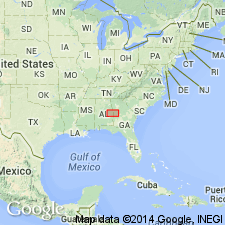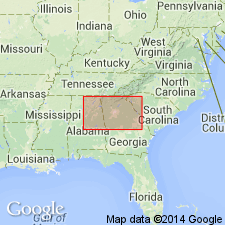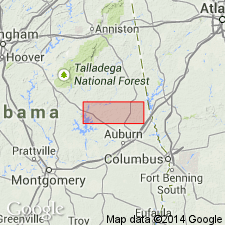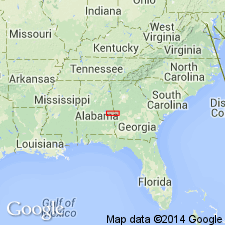
- Usage in publication:
-
- Waresville Formation
- Modifications:
-
- First used
- Named
- Dominant lithology:
-
- Amphibolite
- Schist
- Metaquartzite
- AAPG geologic province:
-
- Piedmont-Blue Ridge province
Summary:
Name is credited to Bentley (in prep), but manuscript has not been published to date. Waresville Formation of the Dadeville Complex is described as an extensive metavolcanic rock unit within the Brevard zone and along the northern edge of the Inner Piedmont. Exposed in Chambers and Tallapoosa Cos, AL, and Heard Co., GA. Consists of interlayered amphibolite, chlorite-actinolite schist, actinolite-feldspathic metaquartzite, and chlorite metaquartzite. Name Ropes Creek Formation is applied to metavolcanics that are of a higher grade but may be equivalent as they appear to intergrade in the Dadeville transition zone.
Source: GNU records (USGS DDS-6; Reston GNULEX).

- Usage in publication:
-
- Waresville Formation/Amphibolite†
- Modifications:
-
- Abandoned
- AAPG geologic province:
-
- Piedmont-Blue Ridge province
Summary:
The Waresville Formation/Amphibolite, never properly established as a formal name, is here abandoned and its rocks are assigned to the Paulding Volcanic-Plutonic Complex.
Source: GNU records (USGS DDS-6; Reston GNULEX).

- Usage in publication:
-
- Waresville Schist
- Modifications:
-
- Reinstated
- AAPG geologic province:
-
- Piedmont-Blue Ridge province
Summary:
Despite abandonment by Higgins (1988), AL State geologists continue to use the term Waresville Schist (See Raymond and others, 1988; Osborne and others, 1988). Unit crops out south of Brevard zone in central Tallapoosa, northwest Chambers, and southeast Randolph Cos. Represents altered and retrograded Ropes Creek Amphibolite.
Source: GNU records (USGS DDS-6; Reston GNULEX).

- Usage in publication:
-
- Waresville Schist*
- Modifications:
-
- Overview
- AAPG geologic province:
-
- Piedmont-Blue Ridge province
Summary:
Inner Piedmont is divided into two groups of rocks, Dadeville and Opelika Complexes (Bentley and Neathery, 1970), divided by Stonewall line. Dadeville Complex consists of Agricola Schist, Waresville Schist, Camp Hill Gneiss, Chattasofka Creek Gneiss, Ropes Creek Amphibolite, Waverly Gneiss, Simmons Crossroads metagranite (informal), and various unnamed mafic and ultramafic intrusive rocks. Opelika Complex consists of Loachapoka Schist, Saugahatchee quartzite, and Auburn Gneiss and schist. Farmville Metagranite intrudes these units. Age of all Inner Piedmont rocks is early Paleozoic. Report includes geologic sketch map.
[Remark reflects usage as published, not as reviewed in draft form. Although GNU review requested informal terms to be inverted, the published version shows that authors did not comply with request. Whatley Mill is misspelled as Whatley Mills in published version; error introduced after GNU review. (GNU records, USGS DDS-6; Reston GNULEX 01/21/94)]
Source: GNU records (USGS DDS-6; Reston GNULEX).
For more information, please contact Nancy Stamm, Geologic Names Committee Secretary.
Asterisk (*) indicates published by U.S. Geological Survey authors.
"No current usage" (†) implies that a name has been abandoned or has fallen into disuse. Former usage and, if known, replacement name given in parentheses ( ).
Slash (/) indicates name conflicts with nomenclatural guidelines (CSN, 1933; ACSN, 1961, 1970; NACSN, 1983, 2005, 2021). May be explained within brackets ([ ]).

